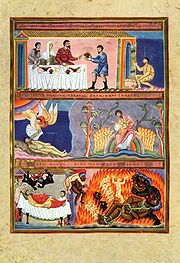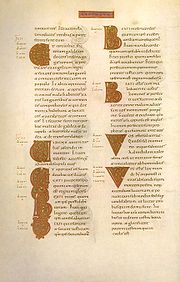
Codex Aureus of Echternach
Encyclopedia


Nuremberg
Nuremberg[p] is a city in the German state of Bavaria, in the administrative region of Middle Franconia. Situated on the Pegnitz river and the Rhine–Main–Danube Canal, it is located about north of Munich and is Franconia's largest city. The population is 505,664...
, Germanisches Nationalmuseum
Germanisches Nationalmuseum
The Germanisches Nationalmuseum is a museum in Nuremberg, Germany. Founded in 1852, houses a large collection of items relating to German culture and art extending from prehistoric times through to the present day...
, Hs. 156142) is an 11th century illuminated
Illuminated manuscript
An illuminated manuscript is a manuscript in which the text is supplemented by the addition of decoration, such as decorated initials, borders and miniature illustrations...
Gospel Book
Gospel Book
The Gospel Book, Evangelion, or Book of the Gospels is a codex or bound volume containing one or more of the four Gospels of the Christian New Testament...
.
The manuscript contains the Vulgate
Vulgate
The Vulgate is a late 4th-century Latin translation of the Bible. It was largely the work of St. Jerome, who was commissioned by Pope Damasus I in 382 to make a revision of the old Latin translations...
versions of the four gospel
Gospel
A gospel is an account, often written, that describes the life of Jesus of Nazareth. In a more general sense the term "gospel" may refer to the good news message of the New Testament. It is primarily used in reference to the four canonical gospels of Matthew, Mark, Luke, and John...
s plus prefatory matter including the Eusebian
Eusebius of Caesarea
Eusebius of Caesarea also called Eusebius Pamphili, was a Roman historian, exegete and Christian polemicist. He became the Bishop of Caesarea in Palestine about the year 314. Together with Pamphilus, he was a scholar of the Biblical canon...
canon tables, and is a major example of Ottonian
Ottonian art
In pre-romanesque Germany, the prevailing style was what has come to be known as Ottonian art. With Ottonian architecture, it is a key component of the Ottonian Renaissance named for the emperors Otto I, Otto II, and Otto III...
illumination. It was produced at the Abbey of Echternach
Abbey of Echternach
The Abbey of Echternach is a Benedictine monastery in the town of Echternach, in eastern Luxembourg. The Abbey was founded by St Willibrord, the patron saint of Luxembourg, in the seventh century...
under the direction of Abbot Humbert.
The manuscript has 136 folios which measure 446 mm by 310 mm. It is one of the most lavishly illuminated Ottonian manuscripts. It contains over 60 decorative pages including 16 full page miniatures
Miniature (illuminated manuscript)
The word miniature, derived from the Latin minium, red lead, is a picture in an ancient or medieval illuminated manuscript; the simple decoration of the early codices having been miniated or delineated with that pigment...
, 9 full page initial
Initial
In a written or published work, an initial is a letter at the beginning of a work, a chapter, or a paragraph that is larger than the rest of the text. The word is derived from the Latin initialis, which means standing at the beginning...
s, 5 evangelist portrait
Evangelist portrait
Evangelist portraits are a specific type of miniature included in ancient and mediæval illuminated manuscript Gospel Books, and later in Bibles and other books, as well as other media. Each Gospel of the Four Evangelists, the books of Matthew, Mark, Luke, and John, may be prefaced by a portrait of...
s, 10 decorated pages of canon tables, and 16 half-page initials. In addition there are 503 smaller initials. The text is writtien in gold
Gold
Gold is a chemical element with the symbol Au and an atomic number of 79. Gold is a dense, soft, shiny, malleable and ductile metal. Pure gold has a bright yellow color and luster traditionally considered attractive, which it maintains without oxidizing in air or water. Chemically, gold is a...
ink. The front cover of the manuscript is an Ottonian treasure binding which dates from about 50 years before the manuscript.
The manuscript was Abbey of Echternach
Abbey of Echternach
The Abbey of Echternach is a Benedictine monastery in the town of Echternach, in eastern Luxembourg. The Abbey was founded by St Willibrord, the patron saint of Luxembourg, in the seventh century...
in today's Luxembourg before it was sold to Ernest II, Duke of Saxe-Gotha-Altenburg, in 1801. Today it is owned by the Germanisches Nationalmuseum
Germanisches Nationalmuseum
The Germanisches Nationalmuseum is a museum in Nuremberg, Germany. Founded in 1852, houses a large collection of items relating to German culture and art extending from prehistoric times through to the present day...
in Nuremberg.

